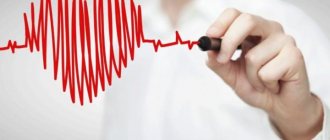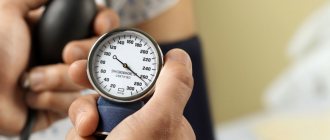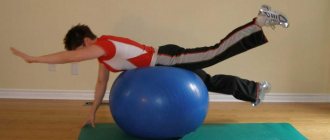If you train remotely or attend in-person classes, you've probably noticed that your instructor repeatedly asks you to take your heart rate during training. Let's figure out how to do it correctly and why it's done.
| Pulse (pulse wave) is a heartbeat that spreads along the walls of blood vessels. Normally, heart rate (heart rate) is equal to the pulse and at rest is 60-90 beats per minute. |
It is more convenient to measure the pulse in places where the walls of the arteries are located close to the skin:
- carotid artery (during training we count the pulse using it);
- radial artery (the doctor usually measures the pulse there);
- temporal artery;
- inguinal artery.
The importance of heart rate during training
Monitoring heart rate during training is necessary to:
- determine the intensity of classes;
- effectively use oxygen to generate energy during aerobic exercise;
- choose a load to develop endurance;
- prevent stress on the cardiovascular system.
Those who have problems with the heart and blood vessels should be especially careful during exercise. For such patients, the load is selected based on an ECG machine with tests on a bicycle ergometer.
A sudden achievement of maximum heart rate is also contraindicated for those who have not previously exercised at all. Like other muscles in the human body, the heart needs time to reach a certain exercise regime. The duration of the preparatory period should be from three to six months.
With the correct load, heart rate should be measured several times:
- before classes;
- after warming up;
- at the end of the main part;
- when the load decreases;
- after classes during the cool down process.
IMPORTANT! Pulse is considered a more objective criterion of literacy in classes, in contrast to well-being.
How to calculate your heart rate for running
To calculate your running heart rate based on your individual heart rate, you need to know your resting heart rate. It is measured in the morning without getting out of bed. For an accurate calculation, take 4-6 measurements and calculate the average value. Maximum heart rate minus resting heart rate is the individual heart rate reserve.
Two formulas are used for calculations:
- for beginners, poorly prepared – 80% of the pulse reserve plus resting pulse;
- for well-trained people – 60% of heart rate reserve plus resting heart rate.
Example: age 40, beginner, morning heart rate results: 63, 67, 62 and 68 beats.
Calculation algorithm:
- Average resting pulse: (63+67+62+68):4 = 65.
- If a person is 40 years old, then his maximum heart rate will be 220-40 = 180.
- Pulse reserve 180-65 = 115.
- For the unprepared, 115x80% = 92.
- Optimal heart rate 92+65 = 157 beats.
Therefore, for such a patient, you need to train with a heart rate of up to 155-160 beats per minute.
Pulse zone
Pulse is the rate at which the heart beats over one minute. There is also the concept of a pulse zone, which determines the range from the heart rate at rest to the maximum load on the body.
In everyday life, a person does not need to monitor his pulse zone. But for athletes this parameter is very important. The fact is that when the heart rate is in only one zone, it promotes weight loss; at high values, the endurance of the human body increases
Help: Each person has his own pulse zone, which is determined using laboratory tests.
How to run with a heart rate monitor
Heart rate monitors are attached in the form of a bracelet (watch) to the wrist joint; you need to not only run with them, but also monitor the recovery of your heart rate after training. Depending on the model, they can measure your heart rate when you touch the screen or record readings at a specified frequency.
The advantage of fitness watches is the ability to sound a signal when entering a dangerous (anaerobic) zone. Such devices are convenient, but at high air humidity and at low temperatures they often give incorrect data. Heart rate monitors mounted on the chest allow you to more accurately determine your heart rate. Their monitor is similarly mounted on the arm, and the sensor covers the chest.
Heart rate monitors
Safe heart rate during exercise
Heart rate is an objective criterion for assessing training load during training. Using heart rate, you can regulate the intensity of your exercise.
During aerobic exercise, heart rate indicators are not informative and cannot be used to regulate strength loads in the gym.
During sports exercises
Physical activity makes the heart beat faster. As a result, the volume of pumped blood is often released into the system to supply the human muscles and organs with oxygen, so the number of shocks increases greatly.
If the body has not previously been exposed to heavy exercise, then a high heart rate during sports is considered normal. For professionals, even during training, the heart rate increases slightly, which is explained by constant cardio loads. The heart muscle gets used to it over time and copes with pumping blood without effort.
Heart rate during strength training
Strength loads are characterized by higher heart rate readings, unlike walking or running. After them, the pulse rises to ninety percent of the maximum, but this value is suitable for healthy people. When there is no preparation or a person has suffered from any illness, the heart rate cannot be increased above 85%. For example, if a person is forty-five years old, then the permissible limit is 85% of the maximum: 220 − 45 = 175, which is 149 beats per minute.
The main thing here is to wait for the pulse to recover before another approach. He should get back to ninety beats per minute. A person should not experience shortness of breath, increased heart rate or discomfort in the heart area. If the pulse has not decreased in seven minutes, then this indicates an incorrectly selected load, and it must be reduced.
Help: If you do strength exercises with a constantly high heart rate, this can disrupt the nutrition of the myocardium.
During cardio training
This category includes fitness training. In other words, your heart rate should be between 135 and 150 beats per minute. But first you need to undergo a special computer examination, which will help determine the upper and lower pulse threshold.
Help: The duration of cardio training should be from forty to fifty minutes.
Heart rate while walking
Walking is extremely beneficial for the human body. They improve well-being, lift your spirits and promote weight loss. The normal heart rate when walking is from 100 to 125 beats per minute. At rest, normal rates are from sixty to one hundred beats per minute.
Heart rate when running in women and men
Normally, the pulse of women and men is different, but besides this indicator, there are others that radically change the final value.
The normal heart rate for men can be determined using averaged data. There are several types of loads, and they all differ in maximum heart rate and training efficiency.
For a man with average physical shape:
- warm-up - from 95 to 115 beats per minute;
- walking - from 115 to 135;
- jogging - from 134 to 154.
Help: Anything higher than the presented indicators is considered excessive and has a negative effect on the human body.
Women's indicators are as follows:
- warm-up - from 97 to 117 beats/min;
- walking - from 117 to 136;
- jogging - from 136 to 155.
While cycling
With such loads, the heart rate becomes seventy percent higher than the maximum. This frequency is used to restore the body after high loads; it can be alternated with an active mode within 70–80 percent.
If classes are held within 75% of the maximum, then endurance increases and fat burning occurs. You can move into the zone with a heart rate of eighty or ninety percent of the maximum and above for no more than one minute.
Heart rate during interval training
These are aerobic exercises that differ from standard ones in that they involve alternating pace and level of stress on the body. This type of training is used by bodybuilders, as interval training helps burn fat without losing muscle mass and increases the volume of the heart, which helps bodybuilders cope with pumping a large volume of blood.
The heart rate during such training ranges from 90 to 100 percent of maximum. Of course, there are programs that assume smaller values. Here everyone chooses the program that suits them best.
Recommendations for beginner runners
For people planning to start running, it is recommended to consider a number of rules:
- You can walk instead of running, but to reach 60-80% of your maximum, you need a fast pace (about 5 km in 45-50 minutes) or climb mountainous terrain for about half an hour;
- the first classes (8 weeks) you only need to walk at a fast pace, and then alternate running and walking for about a month;
- instead of counting the pulse, they focus on the possibility of talking and breathing through the nose, if they do not cause difficulties, then the training is going correctly, discomfort means a violation of breathing and nutrition of the heart;
- running should bring only positive emotions, and not be painful for the body, it is useful only if it is possible not to pay attention to the state of the body (no pain, shortness of breath, weakness, fatigue);
- for the first two months, it is strictly forbidden to try to compete or set higher goals for yourself;
- When running, you cannot stop abruptly, you must definitely start walking, since if the load suddenly stops, loss of consciousness and even cardiac arrest is possible; it takes at least a minute for blood to flow from the muscle tissue to the heart and adjust the rhythm and force of contractions.
Watch the video for tips for beginner runners:
Maximum heart rate in older people
In older people, it is contraindicated to increase the maximum heart rate to ninety percent; seventy percent is enough. These recommendations are suitable for people who do not have heart problems.
But if a person has suffered a heart attack, has angina pectoris or arrhythmia, then it is necessary to select an individual pulse threshold. This can only be done using an ECG with stress. Its meaning is that the patient’s electrocardiogram is recorded at the time of exercise. The doctor uses it to find the maximum limit that the patient should not exceed.
Indicators before, during and after
The norm at rest for people who have not previously engaged in sports, the optimal frequency varies from 60 to 100. It should be measured separately from any activity - sitting on the couch, watching TV or other activity that does not require activity.
It is important to remember that if one morning your heart rate is higher than usual, then you need to stop training for a day.
During movement, the rhythm of contractions depends on the intensity and duration of the race, physical data and other factors that we have already discussed above. There is no need to exceed the limits, especially without the supervision of a trainer.
After running, your pulse should return to normal gradually, but quite quickly. Even after a light jog, you should not stop; you should walk quickly and then at a slow pace.
If your heart rate is low during exercise
A low heart rate during exercise, as noted above, indicates a disruption in the functioning of the cardiovascular system. Doctors say that people who do not reach one hundred beats per minute in six minutes are at risk of developing a complex form of arrhythmia in the future, so they need to be examined.
A slow pulse is affected by blood pressure lowering medications for tachycardia, lack of thyroid hormones, and stomach ulcers. Professional athletes tend to have low heart rates due to overtraining.
You need to know your pulse during training in order to exercise effectively without harming your heart. For the calculation, the maximum value and zone of permissible increase in aerobic loads are used. The correct training plan is one that slows your resting heart rate.
Changes with increased heart rate
When jogging, it is 120-130 beats per minute. This is the most suitable atmosphere, it makes it easier to absorb oxygen from the blood. This has little effect on changes in the body - no weight is lost and no mass is gained. But you won’t be able to get exhausted in the process either.
From the useful:
- Heart training. With the help of such activities, you can improve blood supply to the whole body, stabilize the nervous system, and prevent diseases.
- Memory abilities and reaction speed become better.
- Fat burning level. This running heart rate is the level that is perceived as a signal to use fats instead of carbohydrates for energy. The main rule is to run for at least 20 minutes.
- Health improvement. In addition, stress and anxiety levels decrease.
Higher - from 130 to 145 beats per minute. This is what athletes usually do before going to the main part of the training. This is no longer a health jog, but it’s not yet a training run either. It is advisable to maintain a similar rhythm for at least a couple of minutes, then the body will prepare for more drastic exercises.
What heart rate should be while running - the norm for any future champion varies. A steadily training person has 140 at an increased pace of movement and average speed. Heart rate is a rather individual indicator. Where the beginner is out of breath and unable to continue, the experienced runner is not even tired yet. Age should also be taken into account. If at 55 years old the race causes 140, then at 20 years it is usually no more than 120.
A frequency of up to 165 is considered a training frequency, but this is usually used by athletes who develop endurance. Changes occur in the body that fitness enthusiasts use in the short term to lose fat. You can't run like this for a long time.
When training for acceleration, you need to alternate between the fastest movement at values of 175-180 and slow movement. This beating speed can be harmful if you practice on your own. Acceleration to such body capabilities is allowed only under the supervision of an experienced mentor.
What affects the pulse
In addition to physical activity itself, heart rate can be affected by:
- smoking;
- drinking coffee, alcohol;
- eating food earlier than 3 hours before training;
- hot shower, sauna or bath;
- stress.
All these factors make it impossible to accurately calculate heart rate while running. In such cases, you need to focus on your well-being and the absence of shortness of breath, and drinking alcohol and smoking before training are unacceptable.
We recommend reading the article about why there is pulsating in the ear. From it you will learn about the causes of pulsating tinnitus, as well as methods for diagnosing and treating pulsating tinnitus.
And here is more information about what provokes a low pulse with high blood pressure.
You need to count your heart rate while running to determine the intensity of your workout. Correctly calculated heart rate will help strengthen the heart, burn fat, and increase endurance.








